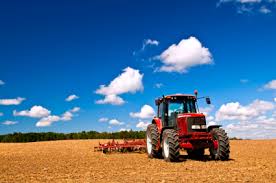India has always been an agriculture based country. Our economy is directly affected by any kind of agricultural change. At the time of independence, it was India’s main occupation. With the advent of Industrial revolution in 1990s, the structure of the economy has changed. It has greatly affected agriculture in India. Has this affect been possitive or negative? Was this the turning point for Indian economy or just another short lived bubble? Was the influence of such changes confined to our economy or did it spread internationally?
Industrialization has introduced modern tools and techniques, which now are a part and parcel of the agricultural sector. Machines like tractors, reapers, harvesters and techniques like crop rotation, new irrigation methods have improved the quantity and volume of the agricultural produce. According to the data provided by RBI, the average yield of rice, wheat and pulses have gone up from 1123, 1307 and 524 (kilogram per hectare) in 1970-71 to 2240, 2938 and 689 (kilogram per hectare) in 2010-11. Industries have also contributed in the development of proper markets for both agricultural and manufactured goods. Manufacturing and tertiary sectors have come into existence due to the support of agricultural inputs. The data also shows that the manufacturing sector contributed 13% of GDP (2013) and that the agricultural sector, 18.2%, meaning thereby nonexistence of any one sector would decline the GDP by significant numbers. Development of these sectors has led the economists to focus on those areas that would provide comparative advantage to the Indian economy, thus facilitating trade among nations. The share in world total exports was 3.25% while that in world total imports was 2.84% in 2013, thus making India self sufficient in most of the aspects (data taken from WTO website). Emergence of industrial sector has resolved the problem of disguised unemployment prevailing in the agricultural sector. India still engages 49% of the population in agriculture and only 20% of the population in industry according to CIA (2012). Thus, agriculture and industry are the helping hand for each other.
Agreed upon is the fact that the two sectors are complementary to each other but the competitive spirit among them cannot be hidden. With the emergence and development of other sectors in India, the people engaged in agriculture, mainly farmers have been neglected to a large extent. The greed to move fast has led politicians and economists to ignore the suicidal attempts made by the farmers. According to the National Crime Records Bureau, in 2012, 13754 suicides were reported. Also, the structure of the labour force has witnessed continuous alterations, leaving few communities of the society unemployed and underdeveloped. After the industrial revolution, farmers were forced to produce only certain crops which led to intensive farming and infertility of land, thus affecting the agricultural health.
Agriculture and Industry go hand in hand when it comes to economic development, only until the welfare of all the sections of the society are taken care of. Both the sectors, their complementary and competitive nature, are vital for a developing country like India. What must be kept in mind is that both the sectors should be geared by balanced growth by the economists so that neither of the sectors is left behind.





41 Comments. Leave new
Very informative and highly impressive article. Keep posting such articles.
Thank you Arpita 🙂
I believe since 70% of Indian population is associated with agriculture, hence the government should not neglect it to develop other sectors. There is a lot that can be done to boom this sector. IT and engineering can play a big role in this. Setting up basic infrastructure for this sector in itself would be a big step.
Indeed true Vedangi. The government must take care of that !
Very informative
Thanks Nupur ! Its good to hear from you o:)
I totally agree with the fact that agriculture and industry must grow together !
Cool 😀
The topic is really good. and so is the material written.
Thanks 😉
Indeed informative.
I’m so happy you all went through it completely !
Nice
Charu thanks !
Good job done!
Thanks Aishwarya
The data so well supports the subject matter. Well explained 🙂
Thanks:)
both the sectors backbone stand to the country… vry knowledgeable
Very informative..Good job!Keep it up.
Thank you Chitranshi. This means so much to me when it comes from you!
indeed a nice complementary article but a major point that should have been highlighted was the uneducated and unaware farmers that do not know how to use the techniques of industry and have no idea about the use of HYV seeds till now.. thus if we consider this point will it go complementary to industrial sector or competitive..???
I absolutely agree to you and the only solution which comes to my mind is that the government must support the farmers to have knowledge about the know-how of the modern techniques.
agriculture and industry are two sides of the same coin. i believe for any economy special reference to Indian Economy both should go hand in hand with same changing rate n in the same direction
True that. The direction of our efforts to bring them together must also be in correspondence to the Indian economy.
Well explained Shatakshi. Keep writing! 😀
Thanks Kriti. You too. 🙂
steps should b taken towards agricultaral sector which is a great source of gdp growth.
This is d part where govt doesnt emphaize much
I feel that the government must emphasize on the sectors equally because though agriculture is a major contributor of GDP, industry is an emerging one.
It is both sector are important of a farmer.
I totally agree with that!
being an economist i feel that both sectors are equally impprtant for the economy to grow
Yes. Indeed.
Good article
Good article
Thank you Rahul!
nice to read and also informative…!
Thanks Padmaa 🙂 Its always great to see people liking your blogs!
Both should go hand in hand for the devolopment of the country
well written 🙂
VEry well Written 😀
Unique topic 😀 and explained well 😀
well explained